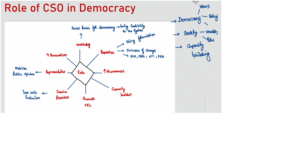UPSC Mains 2021 GS-2 Hits from DIADEMY IAS Mains Programs
Qn1. ‘Constitutional Morality’ is rooted in the Constitution itself and is founded on its essential facets. Explain the doctrine of ‘Constitutional Morality’ with the help of relevant judicial decisions. (Answer in 150 words)
OUR MAINS BOOSTER CONTENT

Qn2. Discuss the desirability of greater representation to women in the higher judiciary to ensure diversity, equity and inclusiveness. (Answer in 150 words)
OUR MAINS BOOSTER CONTENT (Crux notes given as part of MAINS BOOSTER)
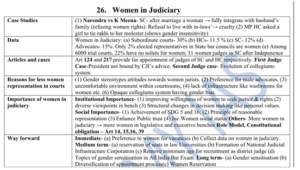
Qn3. How have the recommendations of the 14th Finance Commission of India enabled the states to improve their fiscal position? (Answer in 150 words)
OUR MAINS BOOSTER CONTENT
Discussed in Fiscal federalism classwith proper data and facts about state finances
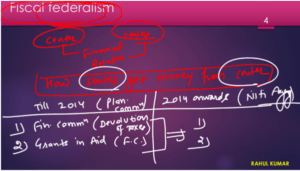


Qn4. To what extent, in your view, the Parliament is able to ensure accountability of the executive in India? (Answer in 150 words)
OUR MAINS BOOSTER CONTENT
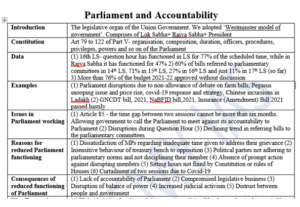
Qn5. “Pressure groups play a vital role in influencing public policymaking in India.” Explain how the business associations contribute to public policies. (Answer in 150 words)
Our Mains Booster Content
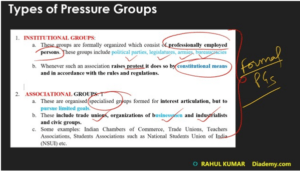
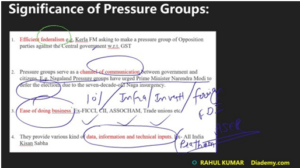
Qn6. “Besides being a moral imperative of Welfare State, primary health structure is a necessary pre-condition for sustainable development.” Analyze. (Answer in 150 words)
DIADEMY MAINS BOOSTER CONTENT – Exact Hit
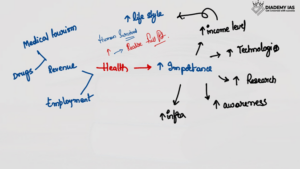

Qn8. Can the vicious cycle of gender inequality, poverty and malnutrition be broken through the microfinancing of women SHGs? Explain with examples. (Answer in 150 words)
OUR MAINS BOOSTER CONTENT 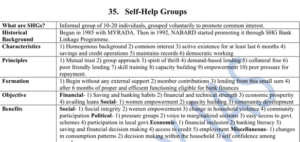
Also covered “MICRO FINANCE “ as a separate topic in comprehensive manner
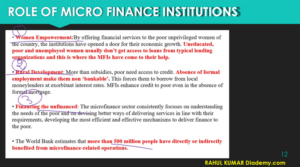

Qn11. The jurisdiction of the Central Bureau of Investigation(CBI) regarding lodging an FIR and conducting probes within a particular state is being questioned by various States. However, the power of States to withhold consent to the CBI is not absolute. Explain with special reference to the federal character of India. (Answer in 250 words)
OUR MAINS BOOSTER CONTENT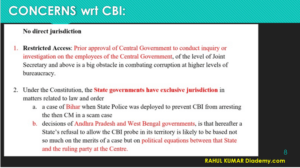
Qn12. Though the Human Rights Commissions have contributed immensely to the protection of human rights in India, yet they have failed to assert themselves against the mighty and powerful. Analyzing their structural and practical limitations, suggest remedial measures. (Answer in 250 words)
OUR MAINS Test SERIES as well as Mains Booster Content
OUR MAINS BOOSTER CONTENT
Limitations of NHRC and SHRC
- Limited time period to enforce investigation: One of the major drawback is that the commissions cannot investigate an event if the complaint was made more than one year after the incident. Therefore, a large number of genuine grievances remain unaddressed.
- Lack of Tooth: The functions of the commission are largely re-commendatory in nature. It lacks the power to enforce decisions.
- Less values to its recommendations:Governments often ignore the recommendations completely or furnish a long bureaucratic discourse on how compliance with the recommendation is not in the public interest.
- Lack of Clarity for recruitment of judges: The Act requires that three of the five members of a human rights commission must be former judges but does not specify whether these judges should have a proven record of human rights activism or expertise or qualifications in the area.
- Limited scope for SHRC: State Human Rights Commissions cannot call for information from the national government, which means that they are implicitly denied the power to investigate armed forces under national control.
- Lack of powers wrt investigations: Even the powers of the National Human Rights Commission relating to violations of human rights by the armed forces have been limited to simply seeking a report from the Government, (without being allowed to summons witnesses), and then issuing recommendations.
- Lack of Manpower: Most Human Rights Commissions are functioning with less than the prescribed five Members. This limits the capacity of commissions to deal promptly with complaints, especially as all are facing successive increase in the number of complaints.
Context: Protection of Human Rights (Amendment) Bill 2019 passed in Lok Sabha.
The bill aims to accelerate the process of appointmentof chairperson and members of the National Human Rights Commission (NHRC).
The Bill amends the Protection of Human Rights Act, 1993. The Act provides for a National Human Rights Commission (NHRC), State Human Rights Commissions (SHRC), as well as Human Rights Courts.
| CHANGES | 1993 BILL | AMENDMENT |
| Composition of NHRC | the chairperson of the NHRC is a person who has been a Chief Justice of the Supreme Court. | A person who has been Chief Justice of the Supreme Court, or a Judge of the Supreme Court will be the chairperson of the NHRC. |
| Inclusion of woman member | for two persons having knowledge of human rights to be appointed as members of the NHRC. | three members to be appointed, of which at least one will be a woman. |
| Other members | chairpersons of various commissions such as the National Commission for Scheduled Castes, National Commission for Scheduled Tribes, and National Commission for Women are members of the NHRC | Inclusion of the chairpersons of the National Commission for Backward Classes, the National Commission for the Protection of Child Rights, and the Chief Commissioner for Persons with Disabilities as members of the NHRC.
|
| Chairperson of SHRC | a person who has been a Chief Justice of a High Court | a person who has been Chief Justice or Judge of a High Court will be chairperson of a SHRC. |
| Term of office | five years or till the age of seventy years, whichever is earlier | reduces the term of office to three years or till the age of seventy years, whichever is earlier. |
| reappointment of members of the NHRC and SHRCs | five-year limit for reappointment. | The Bill removes the five-year limit for reappointment. |
| Powers of Secretary-General of the NHRC and a Secretary of a SHRC | exercise powers as may be delegated to them | exercise all administrative and financial powers (except judicial functions), subject to the respective chairperson’s control.
|
| Union Territories | central government may confer on a SHRC human rights functions being discharged by Union Territories | Functions relating to human rights in the case of Delhi will be dealt with by the NHRC. |
Qn14. Explain the constitutional provisions under which Legislative Councils are established. Review the working and current status of Legislative Councils with suitable illustrations. (Answer in 250 words)
OUR MAINS TEST SERIES QUESTION :
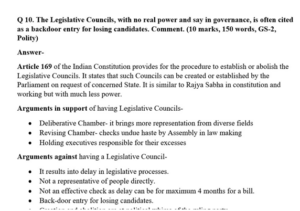
Qn15. Do Department-related Parliamentary Standing Committees keep the administration on its toes and inspire reverence for parliamentary control? Evaluate the working of such committees with suitable examples. (Answer in 250 words)
OUR MAINS BOOSTER CONTENT



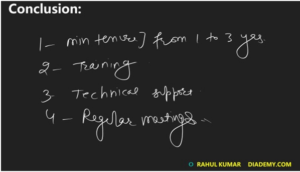
This topic covered in most comprehensive manner
Qn16. Has digital illiteracy, particularly in rural areas, coupled with lack of Information and Communication Technology(ICT) accessibility hindered socio-economic development? Examine with justification. (Answer in 250 words)
OUR MAINS BOOSTER CRUX CONTENT
- Digital India
| Introduction | To- 1) Drive job creation and economic growth 2) Significantly improve efficiencies in service delivery 3) Leverage technology for inclusive, sustainable and participatory development by 2022-23 |
| Data | India’s cash to GDP ratio is > 14%,UPI, BHIM transactions increased to 3.31 lakh, Digital Wallet transactions doubled,eNAM : About 1000 mandis integrated, eHopital : >170 Hospitals,10% rise in net penetration led to a 1.4% increase in GDP : TRAI, India has $50 bn investment in AI R&D, Data and AI will contribute close to half a trillion to India’s GDP by 2025 : NASSCOM |
| Pillars of Digital India | 1) Broadband highways 2) Universal access to mobile connectivity 3) Public Internet Access Programme 4) e-Governance 5) e-Kranti (NeGP 2.0) 6) Information for All 7) Electronics manufacturing 8) IT for Jobs 9) Early harvest programmes |
| Achievements | 1) Digital payments 2) e-KYC 3) JAM Trinity |
| Challenges | 1) slow implementation of projects 2) lack of legal framework 3) top-down model |
| Constraints | Operational– 1) broadband connectivity 2) digital access 3) content in local language 4) availability of e-services Human resource– 1) digital literacy Safety– 1) Cyber security |
| Way forward | Data– 1) low-cost devices 2) Data access 3) data speed 4) quality content 5) local languages promoted Safety– 1) cyber security Miscellaneous– 1) green technology 2) power supply 3) Scientific temper Service delivery– 1) e-governance services |
Qn17. “Though women in post-Independent India have excelled in various fields, the social attitude towards women and the feminist movement has been patriarchal.” Apart from women education and women empowerment schemes, what interventions can help change this milieu? (Answer in 250 words)
OUR MAINS BOOSTER CONTENT
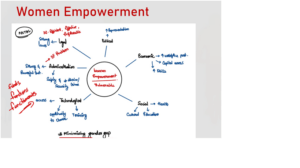 Qn18. Can Civil Society and Non-Governmental Organizations present an alternative model of public service delivery to benefit the common citizen? Discuss the challenges of this alternative model. (Answer in 250 words)
Qn18. Can Civil Society and Non-Governmental Organizations present an alternative model of public service delivery to benefit the common citizen? Discuss the challenges of this alternative model. (Answer in 250 words)
OUR MAINS BOOSTER CONTENT
| Role of NGOs | Social Development– 1) For awareness 2) education 3) welfare of marginalized sections 4) healthcare facilities Employment– 1) research 2) skilling 3) training 4) development of rural areas Environmental-1) environment protection Miscellaneous– 1) surveying 2) culture revival. |
| Funding of NGOs | 1) Both govt. and foreign 2) Foreign funding under FCRA 2010 3) Exemption under IT Act Sec 80G. |
| Issues with NGO | Structural– 1) Opaqueness 2) lack of accountability 3) interference Security-1) hidden motives 2) foreign influence 3) partnership with non-state actors. |
| Problems with NGO | 1) Lack of funding 2) accreditation 3) trained personal 4) reach 5) corruption 6) public distrust |
